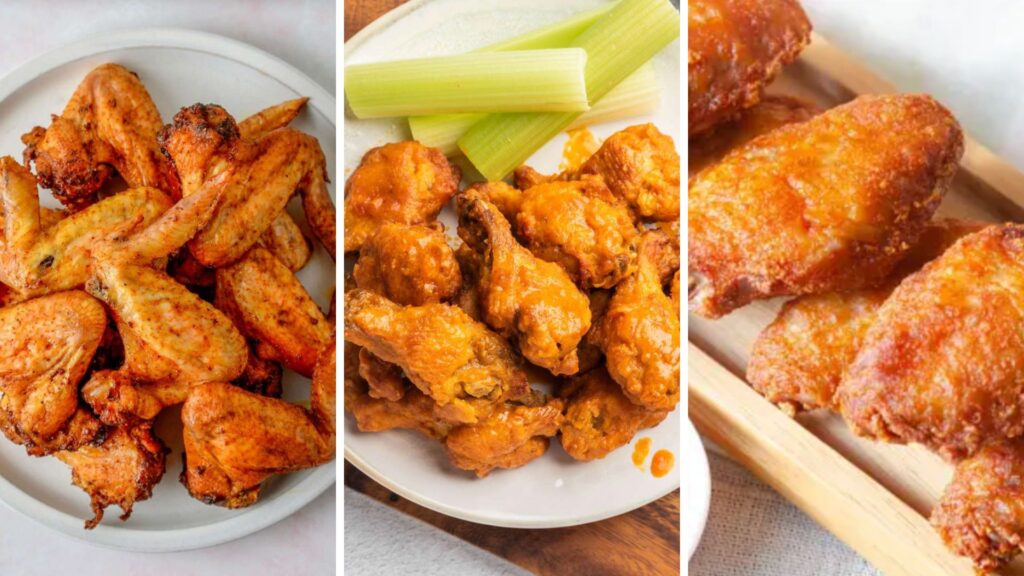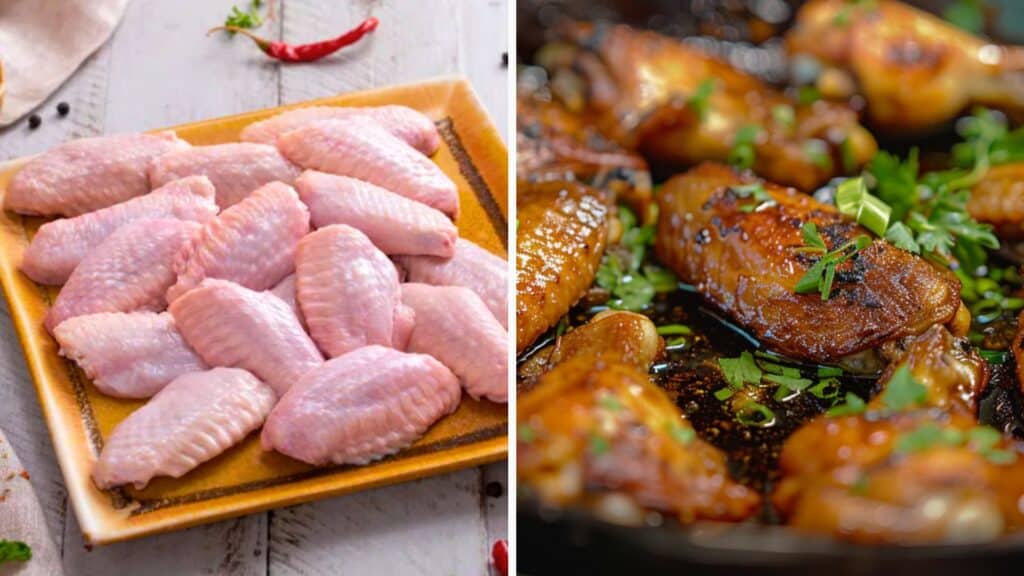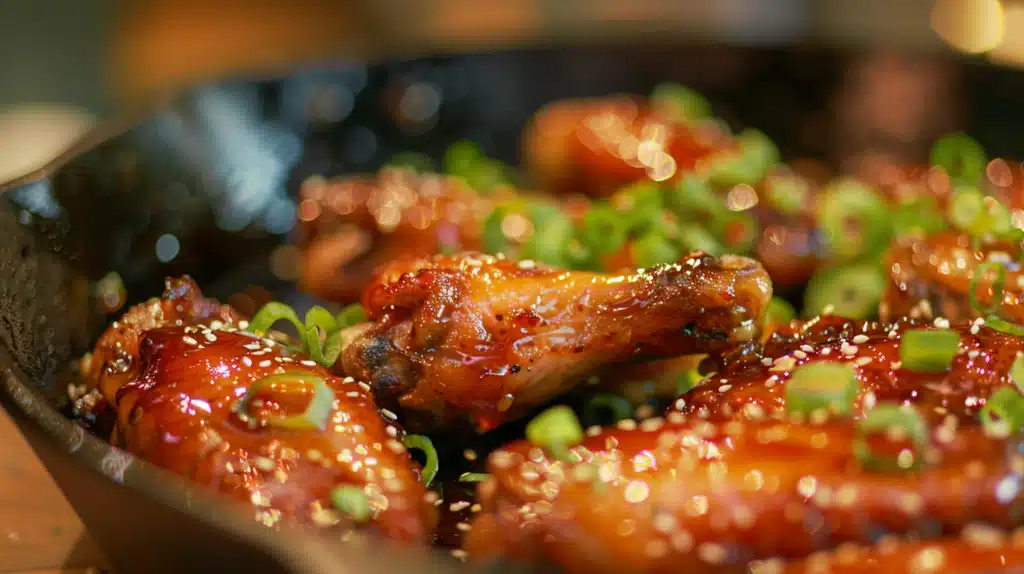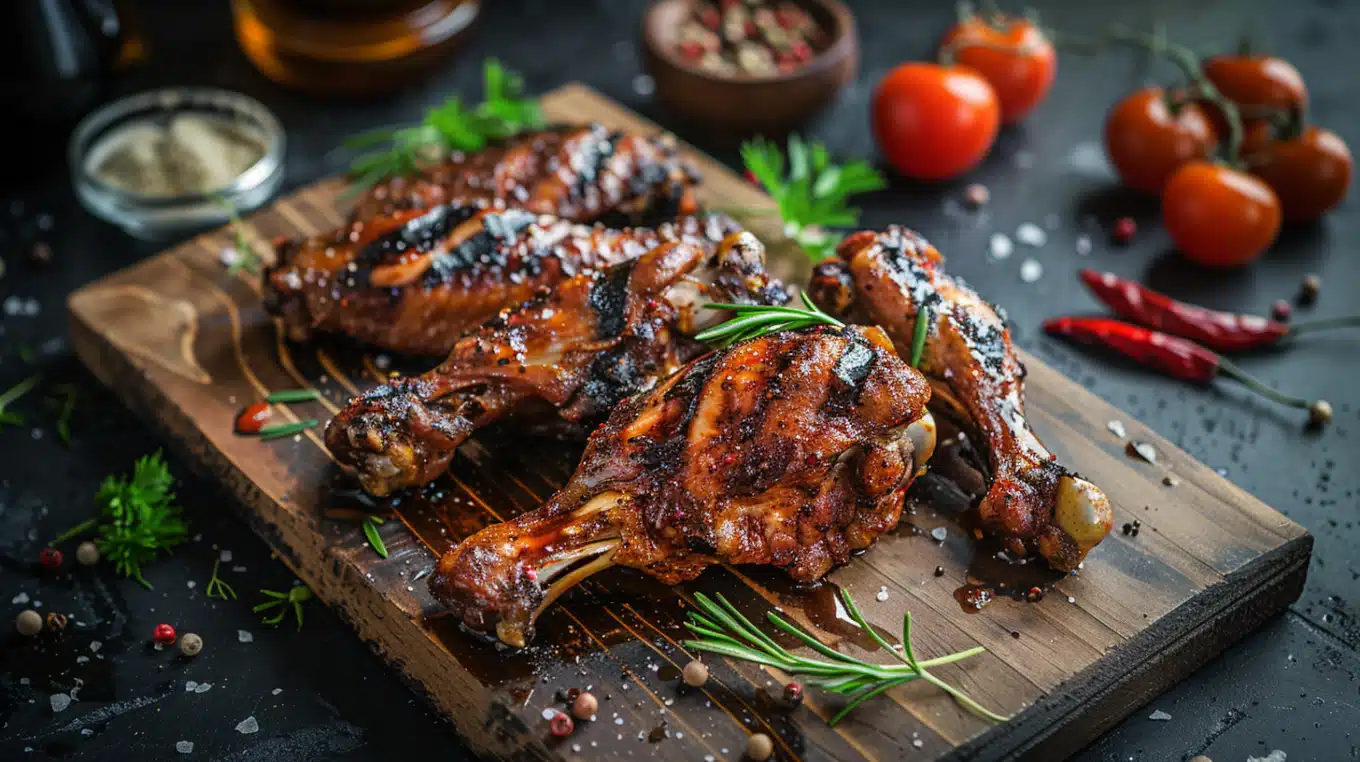Curious about the color of chicken wings? You’re not alone!
Many wonder why some chicken parts are white while others are darker.
The confusion is understandable, especially when it comes to wings. But here’s the surprising truth: chicken wings are a mix of white and dark meat! The drumette part is mostly white, while the flat contains both.
The color difference all comes down to the type of muscle and how much the chicken uses it. So next time you bite into a juicy wing, you’ll know exactly what you’re eating.
Keep reading to learn the fascinating science behind the color of chicken wings, and impress your friends with your newfound knowledge!
Anatomy of Chicken Wings

1. Understanding the Parts of a Chicken Wing
Before we dive into the science behind the color of chicken wings, it’s essential to understand their anatomy.
A chicken wing consists of three distinct parts: the drumette, the flat (also known as the wingette), and the tip (or flapper). Each part offers unique textures, flavors, and cooking possibilities, making it crucial for food enthusiasts to understand their differences.
The Drumette: A Miniature Drumstick
The drumette is the part of the wing attached to the main body of the chicken, resembling a small drumstick. It is meatier than the other parts and consists mostly of white meat.
The drumette is connected to a single large bone, making it a popular choice for its easy eating and rich flavor.
The Flat (Wingette): A Balance of Texture and Flavor
The flat, or wingette, is the middle segment of the wing, characterized by two parallel bones with meat in between. It contains a white and dark meat mix, offering a balance of texture and flavor.
The flat is often favored for its tenderness and versatility in cooking.
The Tip (Flapper): The Overlooked Gem
The tip, or flapper, is the thin, pointy end of the wing. It contains little meat and is mostly made up of skin, tendons, and cartilage.
While often discarded or used in stock preparations, the tip is less favored for direct consumption but valued for its gelatinous qualities in broths and sauces.
2. How Structure Affects Meat Type and Cooking
| Part of Wing | Muscle Usage and Myoglobin Content | Cooking Implications | Nutritional Considerations |
|---|---|---|---|
| Drumettes | Have less active muscle use, leading to lower myoglobin levels and more white meat. | They require less cooking time and are ideal for grilling and frying, as they cook quickly and evenly. | It is lower in fat and calories, so it suits those seeking a healthier option. |
| Flats (Wingettes) | More frequent muscle movement increases myoglobin levels and a white and dark meat mix. | Suited for slower cooking methods like baking or barbecuing, which enhance their flavor and tenderness. | Higher in fat due to dark meat, offering a richer flavor and texture. |
| Tip (Flapper) | It contains minimal meat, mostly skin, tendons, and cartilage, and low myoglobin levels due to limited muscle activity. | Often removed before cooking, it is used primarily in making stocks and broths due to its collagen content. | It contains minimal nutritional value but is valued for its contribution to rich, gelatinous broths and stocks. |
3. Nutritional Content of Chicken Wing Parts
| Part of Chicken Wing | Fat Content | Calorie Content | Preferred Cooking Method |
|---|---|---|---|
| Drumettes | Moderate | Moderate | Grilling, Frying |
| Flats (Wingettes) | Higher | Higher | Baking, Barbecuing |
| Tip (Flapper) | Low | Low | Used mainly for broths |
White Meat vs Dark Meat
| Meat Type | Definition and Characteristics | Role of Myoglobin | Muscle Usage |
|---|---|---|---|
| White Meat | It typically comes from muscles used for quick bursts of activity, such as poultry’s breast and wing muscles. It appears lighter because it contains less myoglobin. | Contains lower levels of myoglobin, resulting in a paler color. | Used for short bursts of activity; relies more on glycogen for energy. |
| Dark Meat | It is found in muscles used for sustained activity, like legs and thighs in poultry. It is darker due to higher myoglobin content. | Higher myoglobin content makes the meat darker and allows it to store more oxygen. | Engaged in continuous exertion, which requires more oxygen and thus more myoglobin. |
Myoglobin Levels and Muscle Activity

1. What is Myoglobin?
Myoglobin is a protein found in muscle cells that plays a crucial role in the color and function of meat. It is responsible for binding and transporting oxygen to the muscles, ensuring they have the necessary supply to carry out their activities.
Understanding myoglobin is key to grasping the difference between white and dark meat in chicken wings.
2. The Importance of Myoglobin in Muscle Function
Myoglobin is essential for muscle function because it helps deliver oxygen to the muscle cells. Muscles used frequently and for sustained activities, such as chicken’s legs and thighs, require a consistent oxygen supply to function properly.
As a result, these muscles have higher levels of myoglobin to meet their oxygen demands.
3. How Myoglobin Affects Meat Color
The presence of myoglobin directly influences the color of meat. Muscles with higher levels of myoglobin appear darker, giving the meat a dark color.
Myoglobin contains iron, which binds to oxygen and gives the protein a red or dark pink hue. Muscles with lower levels of myoglobin have a paler appearance and are considered white meat.
The visual difference between white and dark meat in chicken wings is striking.
The drumette, mostly white meat, has a pale, almost translucent appearance due to its low myoglobin content. In contrast, the flat, which contains a mix of white and dark meat, has a darker, more robust color.
This color difference directly results from the varying levels of myoglobin in the muscle fibers.
4. Comparing Myoglobin Levels: Chicken Wings vs. Legs
| Chicken Part | Myoglobin Levels | Reasons for Myoglobin Levels | Meat Color | Taste and Texture | Preferred Cooking Methods |
|---|---|---|---|---|---|
| Chicken Wings | Low | Wings are less used for sustained flight in domestic chickens. | Lighter | Milder flavor, less tender | Quick cooking methods like grilling or frying |
| Chicken Legs | High | Legs are constantly used for standing and moving, requiring more oxygen. | Darker | Richer flavor, more tender | Slow cooking methods like roasting or stewing |
Clarifying Common Myths

Several common myths about chicken wings can lead to confusion about their composition and nutritional value.
Addressing these misconceptions, we can better understand what chicken wings offer regarding culinary and dietary characteristics.
Myth 1: All Chicken Wings Are Dark Meat
One prevalent myth is that all chicken wings are made of dark meat. However, this is not entirely accurate.
Chicken wings are primarily composed of white meat, particularly in the drumette section. The muscle composition of chicken wings differs from that of legs and thighs, considered dark meat.
Chicken wings are mainly made up of fast-twitch muscle fibers for quick, powerful movements. These fibers contain less myoglobin, the protein responsible for the darker color of meat, compared to the slow-twitch fibers found in the legs and thighs.
As a result, the meat in chicken wings is lighter in color and is classified as white meat.
Myth 2: Color Changes in Cooked Chicken Wings
Another common myth revolves around the color changes observed in cooked chicken wings. Some people may notice that the meat near the bones appears darker after cooking and assume that this indicates the presence of dark meat. However, this color change has a different scientific explanation.
The darker color near the bones of cooked chicken wings is actually due to the migration of pigments from the bone marrow. This is particularly noticeable in younger chickens whose bones have not fully calcified.
During the cooking process, pigments from the bone marrow, primarily from hemoglobin, can seep into the surrounding meat, causing it to appear darker.
This color change is not an indication of the meat type but rather a result of the cooking process and the chicken’s age.
Cooking Techniques and Meat Quality

1. The Impact of Cooking Methods on Texture and Flavor
Cooking methods, including chicken wings, are crucial in determining the meat’s final texture and flavor.
Different techniques, such as grilling, baking, frying, and slow cooking, can significantly impact the eating experience.
Choosing the right cooking method is essential for achieving the desired culinary results. This ensures that the meat is perfectly cooked while enhancing its natural flavors.
2. Exploring Different Cooking Methods
Grilling: Searing in Flavor
Grilling involves cooking meat over high, direct heat, which helps to sear the surface, creating a rich, caramelized crust.
This method can enhance the flavor of chicken wings, giving them a smoky, charred taste. However, grilling can also potentially toughen leaner meats if not monitored carefully.
Baking: Even Heat Distribution
Baking provides a more even heat distribution than grilling, making it an excellent choice for cooking thicker cuts of meat without charring the exterior.
This method is ideal for ensuring that chicken wings cook through evenly while preserving their moisture and tenderness.
Frying: Crispy Exterior, Juicy Interior
Frying involves cooking meat in hot oil, which introduces additional fats and high heat to the cooking process. This method produces a crispy, golden-brown exterior and a juicy, flavorful interior.
However, fried chicken wings may have a higher calorie count than other cooking methods.
Slow Cooking: Tender, Fall-Off-The-Bone Meat
Slow cooking methods, such as braising or using a slow cooker, involve cooking meat at a low temperature for an extended period.
This technique is particularly effective for tougher cuts of meat, as it breaks down the collagen and connective tissues, resulting in tender, flavorful meat that falls off the bone.
3. Elevating Your Chicken Wing Game
Experimenting with Flavors
Don’t be afraid to get creative with your chicken wing flavors. Try different seasoning combinations and marinades to discover your perfect match.
Some popular options include classic buffalo, honey garlic, lemon pepper, and barbecue.
Using Cooking Aids for Precision
To ensure that your chicken wings are always cooked to perfection, consider using cooking aids like a meat thermometer. This tool helps you monitor the internal temperature of the meat, ensuring that it reaches a safe and optimal level.
Basting the wings with their juices or marinade during cooking can also help to keep them moist and flavorful.
Serving Suggestions for Maximum Enjoyment
Serve your chicken wings with various dips and sides to complement their flavor profile. Classic accompaniments include ranch or blue cheese dressing, carrot and celery sticks, and a cold beer.
Consider pairing your wings with a fresh salad or roasted vegetables for a healthier twist.
Nutritional Value of Chicken Wings from Different Fast Food Chains
Fast food generally has a reputation for being high in calories, fat, and sodium while often lacking essential nutrients like vitamins and minerals.
However, the nutritional content of chicken wings can vary significantly between fast food chains, depending on factors such as portion sizes, cooking methods, and added ingredients.
| Chain | Calories per Serving | Total Fat (g) | Protein (g) | Carbohydrates (g) |
|---|---|---|---|---|
| KFC | 290 | 17 | 20 | 8 |
| Wingstop | 210 | 14 | 16 | 5 |
| Buffalo Wild Wings | 350 | 20 | 25 | 12 |
| Popeyes | 310 | 19 | 23 | 10 |
| Chick-fil-A | 280 | 15 | 18 | 9 |
| Domino’s | 250 | 16 | 19 | 7 |
Conclusion
Understanding the anatomy and science behind chicken wings is key to appreciating their unique flavor and texture.
By recognizing the differences between white and dark meat and how myoglobin levels affect muscle color, we can better understand why chicken wings are a delightful mix of both.
Cooking techniques play a crucial role in enhancing the natural qualities of chicken wings, with methods like frying and baking being popular choices.
While fast-food chicken wings may vary in nutritional value, they should be enjoyed in moderation as part of a balanced diet.
So, the next time you savor a plate of chicken wings, take a moment to appreciate the fascinating science behind this beloved dish.
Embrace the flavor, share your knowledge, and let your taste buds soar!
Frequently Asked Questions
What is Dark Meat Caused By?
Dark meat is caused by higher levels of myoglobin, a protein that helps supply oxygen to muscles used more frequently.
Is Dark Meat Unhealthy for You?
Dark meat is not unhealthy when consumed in moderation, as it contains valuable nutrients like iron and zinc.
What is the Most Unhealthy Meat?
Processed meats like hot dogs, bacon, and salami are considered the most unhealthy due to their high sodium levels, preservatives, and saturated fats.
What is the Cleanest Meat to Eat?
The cleanest meats are typically grass-fed, organic, and unprocessed, such as pasture-raised chicken, grass-fed beef, and wild-caught fish.




